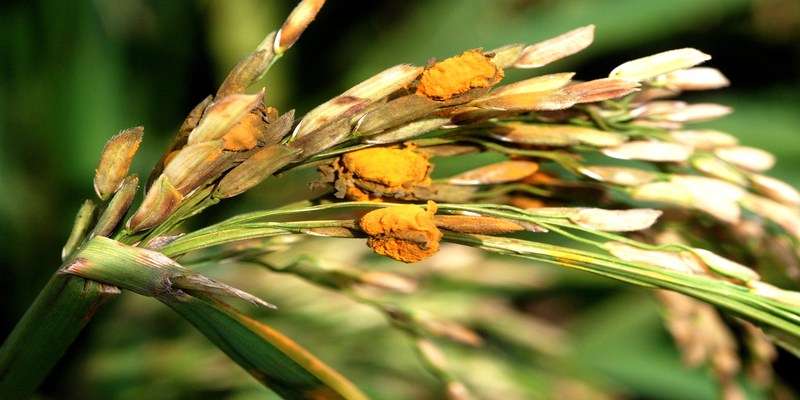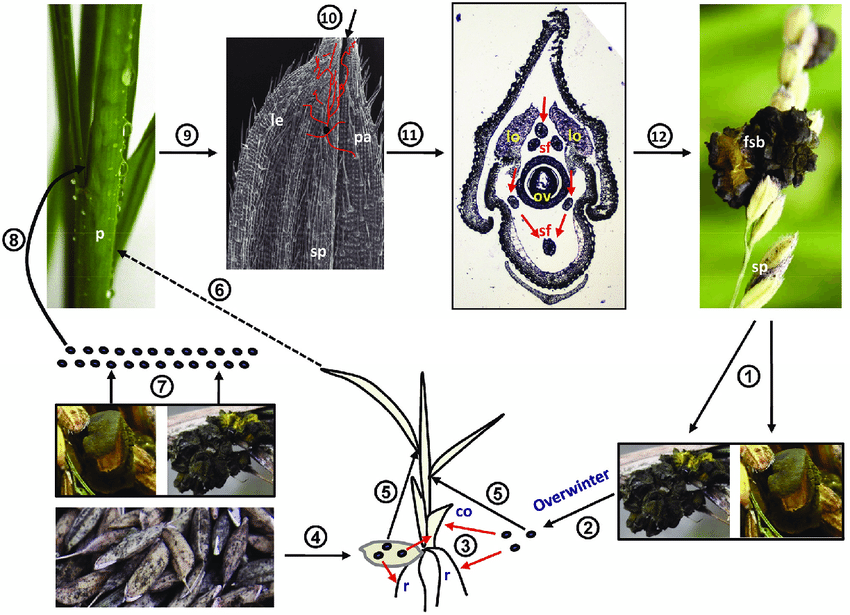False smut of rice, also known as pseudosmut or fake smut, is a fungal disease that affects rice crops. It is caused by the pathogen Ustilaginoidea virens. False smut primarily affects the flowering stage of rice plants, resulting in the transformation of the grains into greenish, powdery spore masses. These spore masses resemble smutted grains, hence the name false smut.
The disease spreads through wind, rainwater, or contaminated seeds. False smut can reduce crop yields and affect grain quality. Farmers employ various management strategies, including crop rotation, seed treatment, and fungicide application, to mitigate the impact of false smut on rice cultivation.
False Smut of Rice Symptoms:

Recognizing the Symptoms of False Smut of Rice: Identifying Signs of Infection-
- False smut of rice is characterized by specific symptoms that can help identify the presence of he disease in rice crops. The symptoms include:
- Individual rice grains are transformed into a mass of yellow fruiting bodies, giving them a distinct appearance.
- The infected grains develop greenish smut balls with a velvety texture, which enclose the floral parts of the rice plant.
- Initially, the smut balls appear small and gradually grow in size, reaching up to 1 cm in diameter.
- The smut balls are usually found in between the hulls of the rice grains.
- Typically, only a few grains in a panicle are infected, while the rest remain normal.
- As the fungal growth intensifies, the smut balls burst, changing their color to orange, yellowish-green, or greenish-black.
- Infection usually occurs during the reproductive and ripening stages of the rice plant, affecting only a limited number of grains in the panicle, while leaving the rest healthy.
- Another symptom is the discoloration of grains, with affected grains showing a change in color.
- The transformation of grains into a mass of yellow fruiting bodies is a prominent symptom of the false smut of rice.
Additionally, the greenish-black smut balls with a velvety appearance indicate the presence of the disease.
As the disease progresses, the smut balls burst and turn black in color, further confirming the infection.
These symptoms provide valuable clues for farmers and agricultural experts to identify false smut of rice, enabling appropriate management strategies to be implemented in order to minimize its impact on rice crops.
Also Read: Bacterial Leaf Blight of Rice: Symptoms, Disease cycle, Management
Impact of False Smut of Rice:
False smut of rice is generally considered a minor disease, but occasional outbreaks have been reported in countries across South and Southeast Asia. These outbreaks have resulted in significant losses, with yield reductions of up to 75% due to decreased grain weight and compromised quality caused by the presence of smut balls.
In Fiji, for example, Graham notes that while a small amount of false smut can be found in any rice field, it rarely leads to substantial losses. However, it is observed to be more prevalent along the south coast of Viti Levu compared to river valleys or dry zones.
Also Read: Sheath Rot Disease of Rice: Symptoms, Disease Cycle, Management
False Smut of Rice Disease Cycle:

In order to effectively manage false smut of rice, it is crucial to grasp the disease cycle and its various stages. By gaining insight into how the disease develops and spreads, farmers and agricultural experts can identify the key indicators and take proactive measures to mitigate its impact.
- Presence of Velvety Smut Balls on Spikelets:
- Check for the presence of velvety smut balls on the spikelets of rice plants.
- These smut balls start off orange in color and mature into a greenish-black shade.
- Individual Rice Grain Transformation:
- Infected plants exhibit a transformation of individual rice grains into a mass of spore balls.
- These spore balls have a velvety appearance or resemble yellow fruiting bodies.
- Growth of Velvety Spores:
- The disease leads to the growth of velvety spores, which enclose the floral parts of the rice plant.
- Initially, the immature spores are slightly flattened, smooth, and yellow, covered by a membrane.
- As the spores mature, the membrane breaks, and they turn orange, later transitioning to yellowish-green or greenish-black.
- Limited Infection within Panicles:
- Typically, only a few grains in a panicle are infected, while the rest remain normal.
- It is common for the smut balls to appear in close proximity to each other within the panicle.
- Chlamydospores and Sclerotia Formation:
- Chlamydospores are formed on the spore balls, appearing as spherical to elliptical warty structures.
- Green spore balls may develop one to four sclerotia in the center.
- Sclerotia overwinter in the field and produce stalked stromata the following summer or autumn, contributing to the disease cycle.
- Role of Chlamydospores and Ascospores:
- Chlamydospores play a significant role in secondary infection, which is a crucial part of the disease cycle.
- Ascospores, produced from the overwintered sclerotia, are believed to be responsible for primary infections.
By recognizing these distinctive features and understanding the disease cycle, farmers can effectively identify false smut of rice and implement appropriate management strategies to minimize its impact on their crops.
Also Read: Bakanae Disease of Rice: Symptoms, Disease Cycle, Management
Management of False Smut of Rice:
Preventing Method:
Izumonas-Best Fungicide
Contents: Pseudomonas Fluorescens
IZUMONAS is a biological product consisting of plant growth-promoting rhizobacteria (PGPR), which are naturally occurring bacteria found widely in nature. This unique product is designed to enhance plant defence mechanisms and promote healthy growth. IZUMONAS can be used on all types of crops without leaving any residue on the plants.
Izumil-Best Fungicide
Contents:
- Extract of Streptomyces griseus: 30%
- Extract of Streptomyces violaceus: 40%
- Dissolving agents: 30%
IZUMIL is a remarkable biotech research product that has been developed to activate the natural defence mechanism of plants. By using IZUMIL, plants can better protect themselves against fungal pathogens, improve their physiological functions, and develop resistance against various harmful microorganisms. Similar to IZUMONAS, IZUMIL can be safely used on all crops without leaving any residue.
Modes of Use:
- Seed Treatment: Mix 5-10 ml of IZUMONAS and IZUMIL per kilogram of seeds in an adequate amount of water. Submerge the seeds in this solution and allow them to dry in a shaded area before sowing.
- Seedling Treatment: Combine 100 ml of IZUMONAS and IZUMIL per 20 litres of water. Dip the roots of the seedlings in this solution for approximately 30 minutes prior to transplanting.
- Soil Application: Mix 500 ml of IZUMONAS and IZUMIL with 30 kilograms of farmyard manure (FYM) or soil. Apply this mixture to one acre of land before ploughing or irrigation.
- Foliar Application: Dilute 2-3 ml of IZUMONAS and IZUMIL each in 1 litre of water. Use this solution to spray the entire foliage of the plants, ensuring complete coverage on both sides of the leaves. It is advisable to shake the bottle before use. For best results, spray early in the morning or evening. If a power sprayer is used, double the recommended dosage.
Cultural Methods:
To effectively manage false smut of rice, cultural control methods can be implemented. These practices aim to reduce disease incidence and minimize its impact. Here are some key cultural methods:
- Destruction of Infected Straw and Stubble:
- It is recommended to thoroughly destroy straw and stubble from infected rice plants.
- This helps eliminate potential sources of disease inoculum, reducing the spread of the disease.
- Plant Resistant or Tolerant Varieties:
- Choose rice varieties that have been found to exhibit resistance or tolerance against false smut in India.
- These varieties have a reduced susceptibility to the disease, offering better protection to the crop.
- Timing of Field Activities:
- Avoid field activities when plants are wet, as moisture promotes the spread of the disease.
- Conduct operations like planting, weeding, and harvesting during dry periods to minimize disease transmission.
- Early Planting:
- Opt for early planting, as crops sown earlier tend to have lower smut ball incidence compared to late-planted crops.
- Early planting can help reduce the disease severity and minimize yield losses.
- Removal of Diseased Plants:
- During harvesting, make sure to identify and remove diseased plants from the field.
- Destroy the removed plants to prevent the release of sclerotia, reducing the primary inoculum for the next crop.
- Clean Field Bunds and Irrigation Channels:
- Maintain cleanliness in field bunds and irrigation channels to eliminate alternate hosts and reduce disease reservoirs.
- Optimal Fertilizer Management:
- Avoid excessive application of nitrogenous fertilizers, as it can promote disease development.
- Follow recommended fertilizer practices to maintain a balanced nutrient supply for the rice crop.
- Regular Disease Monitoring:
- Monitor disease incidence regularly, especially during the rabi season (winter season).
- Timely disease monitoring helps in early detection and implementation of appropriate management strategies.
By implementing these cultural methods, farmers can significantly reduce the impact of false smut of rice and safeguard their crops from this fungal disease.

